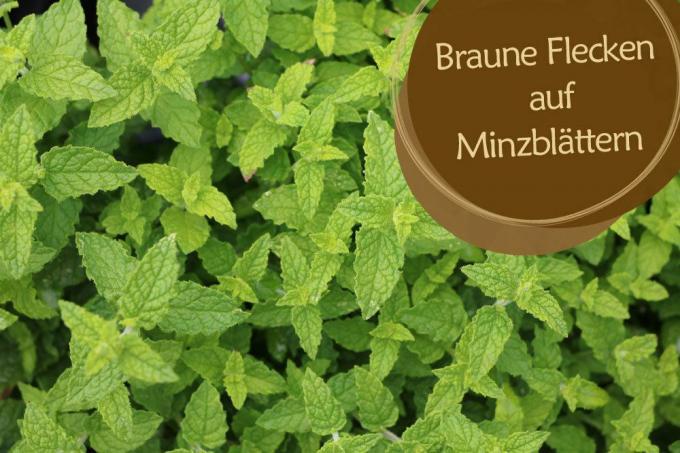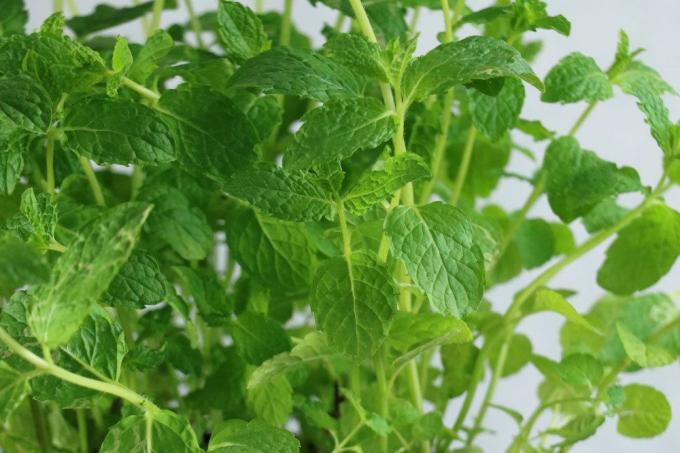
table of contents
- Mint: brown spots
- Mint rust & leaf spot disease
- measures
- Horsetail broth
- Preventing brown mint
mint is a perennial plant. Normally, it is quite easy to cultivate. The plants can be grown outdoors, but also in pots on the balcony or terrace. Although the mint is hardy and robust, it can occasionally be attacked by pests and diseases. Very often the velvety green leaves of the mint are then covered with brown spots and dots. As a rule, two diseases are responsible for this.
Mint: brown spots
Brown spots and spots can attack the leaves and petioles of mint throughout the growing season. It is important to recognize this in good time so that the plants can be treated as quickly as possible. The longer nothing is done, the more likely it is that the plants will die sooner or later. You can also infect other plants. The cause of this disease can be
- Mint rust and
- Be leaf spot disease.
Mint rust & leaf spot disease
This disease is caused by rust fungi, an order of mushrooms. The spores of these fungi, more precisely of Puccinia menthae, can attack the plants during the entire vegetation period. A warm and humid climate in particular increases the risk of infection drastically.
Note: The spores of the mushrooms live as parasites. In doing so, they do not kill the plant tissue.
During the summer months it is therefore advisable to check the mint plants regularly for changes. This is the only way to act quickly if an infection with mint rust has occurred. If there are already small brown spots around the infection site, the mint rust can quickly spread over the entire plant. The first symptoms can appear as early as April. These include
- initially chlorotic (light green to yellow) spots and dots on the upper side of the leaf
- are limited by leaf veins
- orange-red to cinnamon-brown fruiting bodies with spores on the underside of the leaves in summer
- after bursting on the upper side of the leaf, reddish-yellow bumps around the infection site
- in autumn there are also dark brown to black cushion-like pustules on the underside of the leaves
- severely infected leaves dry up and fall off
- whole shoots wither
- in addition, petioles and stems can also be attacked
- The plants are infested from the bottom up
- older leaves are infected first

Note: Infected plants lose their typical mint aroma. Compared to healthy plants, these contain up to 60 percent less essential oils.
Similar symptoms occur with leaf spot disease. This is very difficult to distinguish from the mint rust. Both cause damage to the same extent, so there is no difference in how they are combated.
measures
Once this and the leaf blotch disease has broken out, no chemical or home remedies will help to combat it. A further spread can only be contained by a radical cut back. the procedure is as follows:
- cut back all shoots close to the ground
- just leave one sleeping eye
- Mint sprouts healthy there again
- Cut back into household waste or burn
- not on the compost heap, risk of spread
- In addition, pour the bed with horsetail broth
- Repeat process
- this brew strengthens new shoots and protects against rust fungus formation
Note: Mint rust not only affects plants from the mint family, but also plants from other plant families such as chamomile, marigold and moons.
Horsetail broth
Regular administration of this brew can increase the resistance of the plants to fungal diseases. The high proportion of silica, but also potassium and saponins strengthens the tissue of the plants. The leaf surface becomes more resistant and fungal diseases can then not spread so easily.
Field horsetail, also known as "horsetail", grows wild in moist places such as Embankments, Ditches and meadow edges. Alternatively, other species such as marsh horsetail, pond or meadow horsetail can also be used.
the Manufacturing a brew from field horsetail is relatively simple:
- Chop 1 to 1.5 kg of fresh field horsetail with sharp secateurs
- alternatively, 150 to 200 g dried horsetail can be used
- Soak the clippings in 10 liters of water in a large saucepan
- Soak for at least 24 hours
- preferably use of rainwater
- then bring everything to the boil briefly
- Simmer for 30 minutes at a low temperature
- Strain the broth with a close-meshed sieve
- let cool down
- Application with watering can or pressure sprayer possible
- when using a syringe, filter the brew through a cotton diaper or a light cotton cloth
- because plant residues can clog the nozzle
- Dilution of the broth in a ratio of 1: 5 with water
After the field horsetail broth has been applied for the first time, the process should be repeated every two to three weeks. For this, not only the plants, but also the soil around the plants should be treated. This promotes resistance and at the same time supplies the plants with valuable nutrients.

tip: The brew should always be applied in the morning in sunny weather. Because the warming rays of the sun intensify the effect of the broth.
Preventing brown mint
Before brown spots and dots on the leaves of the mint have to be combated, some measures should be taken in advance to prevent these diseases. It doesn't even take that much effort to do this.
- Use of healthy or resistant cultivars or species with hairy leaves
- "Multimentha" is recommended
- Constantly loosen the soil around the plants
- weed weeds regularly
- Water the plants from below
- damp leaves increase the risk of infection
- always water in the morning
- water regularly, especially during prolonged dry periods and in summer
- Avoid waterlogging
- when planting in pots, add drainage
- wide planting distance
- to other plants at least 30 cm
- Note crop rotation, annual crop rotation in the bed advisable
- loves light sun to partially shaded places outdoors or on balconies and patios
- Shady places and insufficient distance to other plants encourage the formation of rust fungi
- looking for an airy place
- Avoid blazing sun and heat, especially at lunchtime
- balanced fertilization in the summer months
- Use of organic fertilizers such as nettle liquid or horn shavings
- prune regularly in autumn
- if necessary, transplant or repot
- Timely harvest prevents rust fungus from forming
tip: Should be brown to black spots along with Aphids and Ants occur, then it can quickly lead to the formation of soot thaw. Lice and ants carry this disease. It is then necessary to act quickly. An immediate radical pruning must take place.

Despite all preventive measures, it is necessary to regularly check the mint for brown spots and spots. The diseased plants must be pruned at the first signs.
